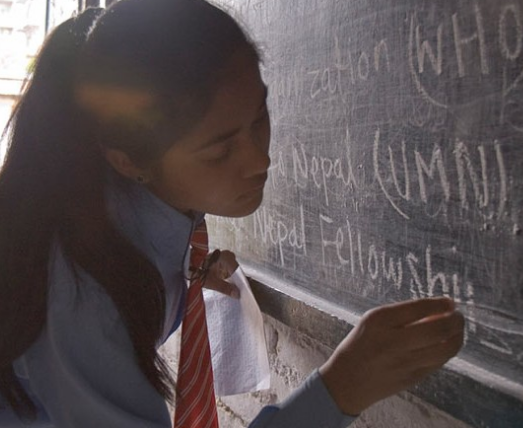Special to The SunBreak by Odawni AJ Palmer.
Suicide is an increasingly significant global public health problem but stigma and other cultural and social factors keep suicide out of public discourse. It’s a silent and solitary act that needs to be talked about at a higher volume.
After viewing a 30-minute rough cut of Scott Squire and Amy Benson’s documentary footage of The Girl Who Knew Too Much, which explores their subject’s suicide in Nepal, this is exactly what we did — a panel-led audience of filmmakers, educators, human rights activists, mental health specialists, and native Nepalese — we talked.
Before they rolled footage, local filmmakers Squire and Benson gave a brief introduction of how they arrived at West Seattle’s Youngstown Cultural Center, presenting this concept piece. In 2008, the couple traveled to Nepal to begin a documentary about education changing the lives of girls who’d received school scholarships via a non-governmental organization’s program.
One of the girls, Shanta, captured their attention with her intelligence and ambition, so they followed her on her journey. The following year, after the couple returned to Seattle to take a break from filmmaking, they learned that Shanta had hung herself. Devastated and confused, Squire and Benson returned to Nepal and interviewed her family about Shanta’s suicide. They wanted to try to understand what happened. What went wrong? What could have been done to help Shanta? Why did Shanta commit suicide?
Why does anyone commit suicide?
With The Girl Who Knew Too Much, Squire and Benson have the tragic opportunity to show us what it looks like before someone acts to take her life. They asked us to consider some questions as we watched the footage: What theme speaks to you? What did Shanta need? Why should we care? What can we do?
It’s clear that Shanta was isolated by her pursuit of education.
“Being smart is difficult in my situation,” she says. She has moved to the city to attend school, and away from her parents and younger sister who live in a low-resource rural community. She now lives in a crammed studio space with her brother, sister-in-law, and toddler-aged niece. Shanta sits at her “desk,” the edge of the family’s shared bed, maintaining focus on her studies as her niece makes many attempts to play and her sister-in-law sits nearby.
The film cuts to a later interview with her sister-in-law: “It’s not good to be over intelligent. Look what happened to her,” she says after Shanta has killed herself. The sister-in-law blames intelligence and Shanta’s drive to learn, rather than consider that Shanta’s decision to kill herself was possibly a result of a deep internal pain. (Suicide is illegal and punishable in Nepal.) The disconnect is clear.
Additionally, Shanta is a Dalit, a member of a lower Indian caste. She gets shoved out of line by women of a higher caste when she goes to town to collect water. She is met with regular social oppression and discrimination but Shanta keeps with the “culture of silence.” Women in Nepal are pressured to suppress their negative emotions. Could this be a precipitating factor in Shanta’s decision to hang herself? Did she have friends or adult figures to talk to? Who did Shanta look to for emotional support? Did she feel as though she could seek support?
These are questions that Squire and Benson hope to find answers to.
In fact, Shanta’s story is one of many stories of suicide in Nepal. Her story is one of many, many stories of suicide in countries around the world. Stigma is a globally pervasive factor in our ignorance of a major public health problem, one that keeps suicide a silent issue.
Recent research finds that “[m]ental disorders account for 11.1% of the total burden of disease in low-resource countries such as Nepal.” In their conclusion, the authors suggest culture-specific approaches to addressing suicide based on their research findings. A 2010 report by the World Health Organization tells us, “[i]n low and middle-income countries 75% of people do not get the mental health services they need.” But WHO’s mental health Gap Action Program (mhGAP) argues that “with costs as low as US $2 per person per year, and with proper care, assistance and medication, millions can be treated.”
In Squire and Benson’s The Girl Who Knew Too Much, they’re working to unearth the causes of a single suicide in Nepal. But their film will have the power to ignite and inspire conversations about suicide in private and public spheres wherever it’s shown. Suicide is not any individual’s issue. It’s a global public health problem, one complicated by the fact that treatment “will need to be tailored to suit the different etiology, culture, expectations, resources, skills and spiritual beliefs of both patient and doctor” (Benson & Shakya).
Because suicide is so often an act shrouded in shame, silence, and secrecy, there are a lot of questions to ask. A suicide survivor, J.D. Schramm, said at a TED Talk, “because of our taboos around suicide, we’re not sure what to say, and so quite often we say nothing…. It’s a conversation worth having.”
Scott Squire and Amy Benson are raising funds to return to Nepal in January 2013 to complete their film. They will follow up with Shanta’s sister and conduct interviews and on-the-ground research to learn more about what happened in Shanta’s case and to learn more about suicide in Nepal. Benson tells us that Nepal’s first suicide hotline will be set up, “This will help us to see who’s calling in and why.”
Contributions to The Girl Who Knew Too Much project can be made at this Kickstarter page. You can find project updates here.
***
- The National Suicide Prevention Lifeline: 1-800-273-TALK (8255)
- For Hearing & Speech Impaired with TTY Equipment: 1-800-799-4TTY (4889): For veterans, press 1; en Español oprima el 2.
- The National Suicide Prevention Lifeline
- International suicide prevention and crisis center contact information
